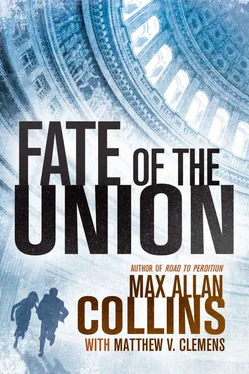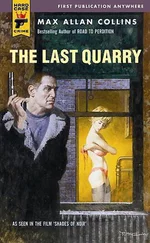Reeder just sat staring through the blank mask he gave the world, reading Murton’s body language. On hearing that Blake had been murdered, the supervisor had crossed both his feet and his arms, as if it were cold in this toasty room. Going into a defensive posture because he had something to hide, possibly; or perhaps just shielding himself from the sad news.
Rogers was asking, “Do you know anyone who might have wanted Lester Blake dead, Mr. Murton? Work conflicts perhaps, someone with a grudge that Mr. Blake may have mentioned...?”
Murton shook his head. “Lester was a good employee, a hard worker. Make that a great employee. Quiet but friendly, everybody liked him.”
Didn’t they always, Reeder thought.
“I’d go so far,” Murton said, uncrossing his arms, “as to call him a friend.”
“Close friend?”
“Well... close for a workplace friend. He’s been on my crew here at the Capitol for, oh, almost twenty years. We went out for a drink after work, now and then — maybe once a month? But then, so did most of the crew.”
“No other socializing?”
“No. Well, our respective kids’ weddings. That’s about it.”
“He get along with the rest of the crew?”
“Yeah, like I said — everybody liked him.”
“What were his duties, exactly?”
Murton uncoiled a bit. Work was a more comfortable subject than murder.
“Recent years, with all his experience, he got the most important maintenance jobs. When something needed to be done right, I turned to Lester. Things break down in the Capitol, you know — it’s a beautiful building but it’s old. Anything we can fix ourselves, we do — hardly ever contract outside workers. So, Lester, he was usually busy.”
Reeder asked, “Was he in on repairing the dome?”
“No, that’s the kind of job we do bid out.”
Reeder nodded.
Rogers asked, “What was Lester’s most recent project?”
“A big one — he oversaw the installation of a new furnace.”
Could you construct a furnace out of Senkstone?
Miggie had talked about desks and chairs, but they didn’t have moving parts, like a motor-driven machine. Mig mentioned making a computer of Senkstone, too, but that was only an object that looked like a computer, right? A 3-D rendering?
Could something mechanical be built entirely out of plastic explosive?
Reeder said, “We’d like to have a look at the new furnace.”
Murton frowned so hard, it was like all of his features had converged on the center of his face. “Why would you—”
Rogers, staying right with him, said, “It may have a bearing on our case.”
Ackley was frowning, too, but in a different way. “Is this something I need to worry about?”
Reeder said, “We’re just doing some due diligence, Bob. I’ll let you know if the threat level goes from green to blue.”
“You do that,” the chief said, hard-eyed. “Ron, you wanna show our guests our brand-new furnace?”
The supervisor, confused as hell, shrugged. “I can do that.”
Everybody got up but Ackley. Reeder and Rogers left their topcoats behind in the chief’s office and followed the maintenance supervisor into the corridor. Soon Murton was leading them down into the vast, well-lit Capitol basement, roaring with the merged vibrations of what looked like an underground city of machines.
Wide concrete aisles were on either side of an M. C. Escher design of pipework, furnaces, air conditioners, water heaters, and more. Pipes of metal, PVC, and copper snaked everywhere — upward to provide heat, air conditioning, water, downward for drainage.
Murton stayed in the lead, taking them on a guided tour of an underground world civilians never got to see.
“The Capitol Power Plant provides electricity and natural gas for us,” Murton said, working his voice up over the din, “in addition to almost twenty other federal buildings in the Capitol Hill area.”
Reeder, nearly shouting, asked, “Is replacing a furnace routine or rare?”
“We’ve been installing new furnaces in the basement for most of the last ten years, part of the Capitol working to shrink its carbon footprint.”
“How many furnaces replaced recently?”
“Two in the last year — this one, and one under the Senate.” He paused. “No, three , now that I think of it. The one Lester put in? That was a replacement for one that failed its test run.”
They kept walking.
Reeder asked, “How long has the plan to change out the furnaces been on the schedule?”
Murton laughed but it got lost in the din. “For fifteen years, anyway! Each year, the budget either allows us to continue, or not. The last couple years, under Harrison, things have improved. This replacement furnace? Lester just finished that job a week ago. Here it is.”
Murton was gesturing to a sleek new furnace: big, black, geometric, boxes on boxes. Had one of them been in Bryson’s SIM card picture?
Reeder and Rogers stood staring at the thing, like Ahab spotting Moby Dick lounging in the sun, shooting spray from its blowhole — What are you gonna do about it, you one-legged asshole?
“It’s running,” Rogers said, sounding surprised.
The thrum of the black furnace was like an aircraft about to take off.
“Of course it’s running,” Murton said, with an are-you-crazy smirk. “It’s winter!”
While Rogers tried to explain to Murton that the furnace might have been sabotaged — without getting into the Senkstone aspect — Reeder moved off a little ways to call Miggie. He tucked into a recess that cut the machinery noise somewhat, but still kept his mouth close to the phone — he wanted to be heard, but only by Miggie.
Reeder asked, “Could you 3-D print a working Senkstone furnace?”
“Hell no,” Miggie said. “But... well, you could print each part separately, and then assemble it.”
“Thanks,” Reeder said, not sure he knew much more than before he called.
“What’s up, Joe?”
“Fill you in later, Mig.”
He clicked off, and stepped out from the recess just as somebody bumped into something to his right. Rogers and Murton were down to his left, and he turned toward the sound.
Just another Capitol worker in no hurry, in that same jumpsuit uniform, in the opposite aisle, barely visible through the crowded pipes and furnace. Headed back the way he, Rogers, and Murton had come.
No big deal , Reeder thought, and then the guy glanced his way.
The SIM card blond.
Give the guy credit — he didn’t react at all. Maybe that was what removed any small doubt from Reeder’s mind, since most people, even meeting the eyes of a stranger, would nod or even smile. Not this guy, though again to his credit, he did not pick up his pace. Just looked ahead as if nothing special had occurred, as if he hadn’t recognized Reeder.
But Reeder knew the blond had made him, and moved along with the man, mirroring his pace, separated by the mechanical hum-and-clank snarl of the bowels of the Capitol.
Reeder considered trying to work his way through the clustered pipes and PVC and coils and boxy metal units, but better to wait for a cross aisle — one would have to be coming up. The blond picked up speed, still walking but briskly now.
Rogers had apparently not noticed any of this, talking with Murton, and Reeder cursed himself for not yelling to her before he took up this bizarre chase. She could have cut across and come up behind the blond.
But it had gone down too quickly, and to yell now would spark his prey into a full-on run. He fished for his cell — he could at least send a text to Rogers — and maybe the blond saw that, because he broke into a run and Reeder had no choice but to give damn-the-torpedoes chase.
Читать дальше












